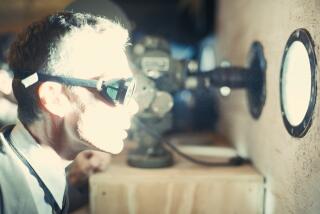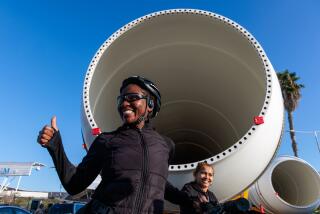Fixing the Spot Where the Space Age Began : And it isn’t in the Soviet Union or the United States. The first self-propelled rocket to leave the atmosphere was fired in Germany, and it was sent aloft by the Nazis.
- Share via
PEENEMUNDE, Germany — Over the decades, the pine forest has edged in along the fringes of Test Pad 7, and grass now covers much of its cracked, weathered concrete apron.
But the substructure--the exhaust ducts, the observation gangways and the gantry tracks--remain clearly identifiable as the place where a team headed by a 30-year-old German scientist named Wernher von Braun presided over the birth of the Space Age nearly half a century ago.
Here, on Oct. 3, 1942, the Nazis launched a 5 1/2-ton V-2 rocket to a height of more than 50 miles, marking the first time that a man-made, self-propelled missile had left the Earth’s atmosphere.
It was a success that two years later would bring terror to the residents of London’s East End--the missile’s prime World War II target--but that would also be seen in the decades ahead as the beginning of man’s conquest of space.
“This is the spot,” noted Peter Profe, one of two curators at a new museum scheduled to open later this spring at Peenemunde. “Here is where the Space Age began.”
The remains of Test Pad 7 constitute only one small part of the sprawling Peenemunde rocket-testing range--a site that has fallen into a gradual, eerie decay since it was abandoned in the final days of the war.
Advancing Soviet forces occupied Peenemunde a few days before the Nazis’ final collapse in early May, 1945. They shipped what they could unbolt or unscrew back to the Soviet Union, destroyed the missile-testing facilities, then departed.
With the exception of a power plant and an old air base near the northern tip of the range--used first by the Soviets, then by the East German air force until its closure last November--Peenemunde became one of East Germany’s many off-limits areas.
It was simply forgotten.
Today, the observation bunkers, storage facilities, main power plant and even the skeleton of the factory used to produce the liquid oxygen rocket fuel are still clearly recognizable as they continue to decay.
Bits of rusting metal parts, either from rockets or from the air war that once raged overhead, still litter the landscape. Indeed, unexploded British and American bombs are so numerous that they make much of the range dangerous to explore.
The fuselage of a British Lancaster bomber, shot down during an air raid in August, 1943, pokes through the surface of a small lake near the old power plant. The remains of a Russian Yak-9, presumably downed in the waning days of the war, lie in a ditch not far from the catapults that launched another Peenemunde development--the V-1 flying bombs that were the world’s first cruise missiles.
Only last year, with German unification and the closure of the MIG air base, was the ban on public access to Peenemunde lifted and a debate launched on the area’s future.
A western German entrepreneur presented an ambitious plan to build a large Disneyland-style park. It was seriously considered but ultimately rejected by local government officials, who apparently were more interested in preserving the environment of an unusual coastal stretch where sea eagles and other rare birds nest.
“They wanted to promote a gentler kind of tourism,” Profe noted.
Instead, the officials approved a plan that calls for preserving not only an environment left virtually untouched for nearly half a century but also parts of the famous test range.
A large air raid shelter near the power plant is being renovated as a museum and information center that will chart the progress of the modern space technology that began here.
The power plant is being dismantled and reconstructed to hold large aeronautical exhibits, such as a full-scale V-2, models of later rockets and paraphernalia gathered from the range itself. That paraphernalia runs from V-2 nose cones and chain-link elevator controls to a 12-cylinder engine of a World War II German JU-88 aircraft fished from coastal marshland.
One damaged V-2 nose cone was uncovered with the help of documentary film footage that recorded the 1942 crash of a missile shortly after liftoff.
A number of other V-2 components were recovered with the help of a local pensioner, who remembered where he had buried them nearly 50 years before while employed at Peenemunde as an apprentice.
A Soviet-made MIG-21 and a MIG-23 acquired from the air base already sit adjacent to the air raid shelter as exhibits of Peenemunde’s more recent history.
With the base now gone, many see the museum’s success as crucial for the continued survival of the small community of Peenemunde. Its 200 to 300 inhabitants have remained on the western fringe of the old test range largely because of the 90 jobs linked with the power plant.
“Without the tourism option, the place will die,” said Profe.
Certainly the range is rich in history.
“The V-2 can be considered the starting point of today’s space shuttle,” noted Matthias Knopp, curator of astronautics at the Deutsches Museum. “All the big missile carriers developed in the United States and the Soviet Union began with the V-2 rocket.”
The V-1 flying bomb also has its legacy--the U.S. Tomahawks fired at Baghdad during the Gulf War are products of the technology developed at Peenemunde.
Between June, 1944, and March, 1945, the Nazis fired more than 10,000 V-1s at London and southern England from bases in northern France. Although Londoners jocularly dubbed them “doodle bugs” and “Bob Hopes” (you bobbed down and hoped they would pass over), the V-1s, along with the 1,400 bigger V-2s also launched against Britain, exacted their toll.
According to London Imperial War Museum historian Terry Charman, the two missiles claimed a total of 8,948 lives and sapped public morale in a way the Blitz of 1940-41 never did. “The attacks came after D-Day at a time people thought that victory was close,” Charman said. “It was a demoralizing setback.”
Grasping the potential of the technology developed at Peenemunde, the Americans spirited Von Braun and his small team to the United States shortly after the war along with about 100 unused V-2s found in the Harz Mountains of central Germany, the main V-2 production area. The missiles were sent first to Huntsville, Ala., for study, then to the New Mexico desert for firing in tests that formed the beginnings of the American space program.
The Soviets took a second group of Peenemunde scientists to work on a missile program that would eventually produce Sputnik and the first manned space flight.
At its height in 1942-43, the Peenemunde test range attracted a population of up to 17,000 where previously there had been only a sleepy fishing village.
But it also drew Allied bombing raids, beginning in mid-1943, that destroyed the area as an active research center. Slave labor was imported from Sachsenhausen and Ravensbrueck concentration camps to keep the range operating.
By the time the final missile was test-fired there in January, 1945, key staff members and support equipment had moved to underground quarters in the Harz Mountains.
Profe said the official resurrection of the Peenemunde range is scheduled for the first week of May, when the information center opens. But the full exhibit will probably take years to complete.
The Launching Pad for the Space Age
More to Read
Sign up for Essential California
The most important California stories and recommendations in your inbox every morning.
You may occasionally receive promotional content from the Los Angeles Times.













